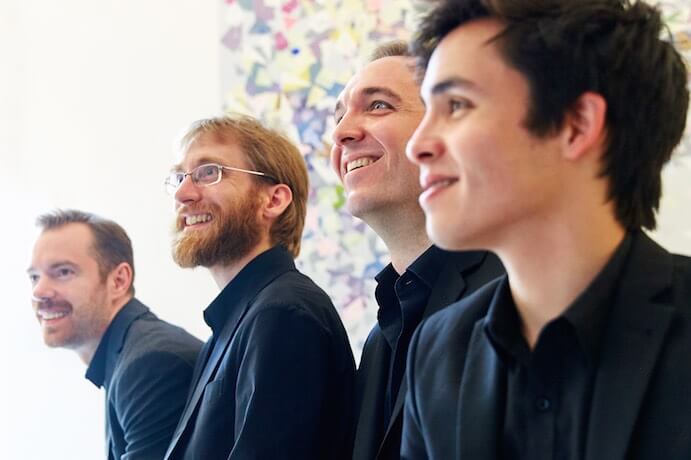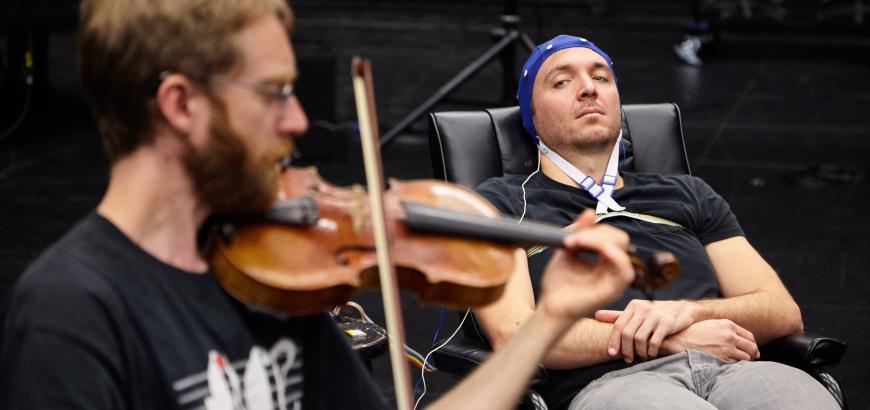In March of 2016, the Andrew W. Mellon Foundation made a generous grant of $750,000 to the University of Washington. The grant seeds the new Creative Fellowships Initiative, an interdisciplinary program that will “advance the field of performing arts by supporting artists in the development of new work and by integrating the performing arts disciplines into the broader curriculum.” Since that time, composers Juan Pampin and Richard Karpen, who are no strangers to experimental music making, have been hard at work in their corner with the eminently progressive JACK Quartet. As co-founders of the University of Washington’s Center for Digital Arts and Experimental Media (DXARTS), Pampin and Karpen are each known for their work exploring musical composition through interactive performance, computer applications, algorithmic strategies, and site-specific sound installations. This new project adds cutting edge scientific technology to their bag of tricks by incorporating the field and tools of neuroscience to monitor the brain activity of the performers as they play. The data collected will provide the basis for a series of compositions they describe as “a new kind of music of the brain,” and in moving the laboratory into the concert hall, may also pave the way for new neurological discoveries.
THIS PROJECT TAKES THE PERFORMERS’ INVOLVEMENT IN THE CREATIVE PROCESS TO A WHOLE NEW LEVEL; HOW HAS JACK RESPONDED TO BEING BOTH THE PERFORMERS AND THE SOURCE OF THE MATERIAL?
We have each worked with JACK Quartet on experimental pieces that include varying degrees of improvisation and live electronics. Based on our previous experiences with JACK Quartet, we felt that they were the ideal group to engage deeply with us on this project. Human Subjects is a project that requires a group of musicians who are extremely advanced as performers and thinkers across a range of musical genres. We also wanted to be sure that our partners in this project had the same kind of abiding commitment to real experimentation and discovery as we have. We knew that JACK Quartet had the kind of collaborative spirit that would enable us all to work as a close team over a few years.

JACK Quartet–Photo by Matt Zugale for Miller Theatre
IS THERE ANY FEAR THAT THE METHODS YOU ARE EMPLOYING MIGHT BE SEEN AS A STERILIZATION OF THE CREATIVE PROCESS, WHERE THE NEW COMPOSITIONS ARE A NOVEL SIDE EFFECT OF THE RESEARCH BEING CONDUCTED?
Research has always been at the core of our work as artists, but we view the work of all of the great artists across time and place in this way. There is no separation between the research Bach would have done to understand and develop tuning systems and organ acoustics and his most mysterious and emotional music. This is also true with great filmmakers who helped invent new lenses and visual effects in the early 20th century. In this way, we undertake research in different forms as an integrated part of the artistic process. In Human Subjects with JACK Quartet, making art has always been the overarching driving force. To make this particular work required that we learn some science and technology that we did not know before, and that we adapt and push the envelope of this knowledge as artistic needs arose during the creation of the HumanSubjects.
WHAT DO THE MUSICIANS PLAY WHILE THE EEG DATA IS BEING COLLECTED AND DOES IT BEAR A CRITICAL RELATIONSHIP WITH THE NEWLY CREATED WORKS?
JACK Quartet has been part of the generative process of this work from the beginning. What they play has been worked out in collaboration with us over three years. We all have many years of experience creating works that arise through a guided improvisation process that results in an agreed upon structure. In the end, the piece exists in a very similar way to the listener as if there were a score, but there isn’t one. JACK Quartet plays the work that now exists within their memories and bodies, and it consists of many different kinds of performance techniques from standard to contemporary string practice to new techniques that we have developed during the work on this project.

Juan Pampin–Photo by Steve Korn
AS A GENERATIVE METHOD OF COMPOSITION, HOW IS THE DATA YOU GATHER FROM THE EEG USED TO MANIFEST YOUR NEW MUSICAL COMPOSITIONS?
The piece was composed through a three-year collaborative process, which involved a series of experiments using real-time brain and nervous system sensing technologies. For instance, the first section of the piece emerged from an experiment in which the rhythm of the brain waves of each player was sonified and sent back to the player via earpiece headphones. Players were asked to imitate the rhythms of the brain waves by playing clicks on their instruments and trying to match the sonified data as closely as possible. In order to achieve this task, performers need extreme concentration, and the closer they get to matching the data, the larger the amplitude of their brain waves gets and the louder the sound coming out of the amplification of their instrument is. Through this section, different EEG bands (theta, alpha, beta, etc.) are used to create a complex polyrhythmic structure.
In other sections of the piece, real-time EMG data coming from both arms of each player is used to control the processing of their instruments. This data was used to train neural networks that allow us to detect multiple gestures–ranging from individual notes played at different rates to trills and tremolos–and to create a continuum between them. This continuous data space allows the players to control processing algorithms that react differently to the rate of firing of the neurons controlling their left and right hands. In a section close to the end of the piece, this strategy is used to create a dense harmonic texture, which the players can sculpt by playing different gestures on their instruments, controlling the multiple parameters of a feedback delay network.

Richard Karpin–Photo by Steve Korn
THE DALAI LAMA’S MIND LIFE INSTITUTE SEEKS TO EXPAND THE SCIENTIFIC APPROACH OF INVESTIGATING REALITY BY INCORPORATING THOUGHT AND INTROSPECTION WITH THE STANDARDS OF EMPIRICISM, OBJECTIVISM, AND TECHNOLOGY. ARE SIMILAR CONSIDERATIONS BEING MADE IN THIS PROJECT TO DIFFERENTIATE THE MIND FROM THE BRAIN, THE CREATIVE PROCESS FROM THE RAW DATA, AND SO FORTH?
Working within the performing arts as we have been doing for many years, we are always very aware of the role of the body in the creation and realization of our works. From that point of view, one can understand not only a mind/body connection or continuum, but that the mind is body–that there is only body. Rather than finding that this point of view diminishes the sense of the mystery of how we think and of what we might call spirituality, if one considers that there is only body, and that the mind is a part of it, the entire idea of who, where, why, how, and what we are is even more deeply astounding and unexplainable! And this is exactly the role of art and our approach to integrating science and technology into it: to create experiences that put the audience into this “zone.”
Originally published at I Care If You Listen | May 14, 2019
EVENT: The JACK Quartet performs Human Subjects on May 18, 2019 at Meany Center
